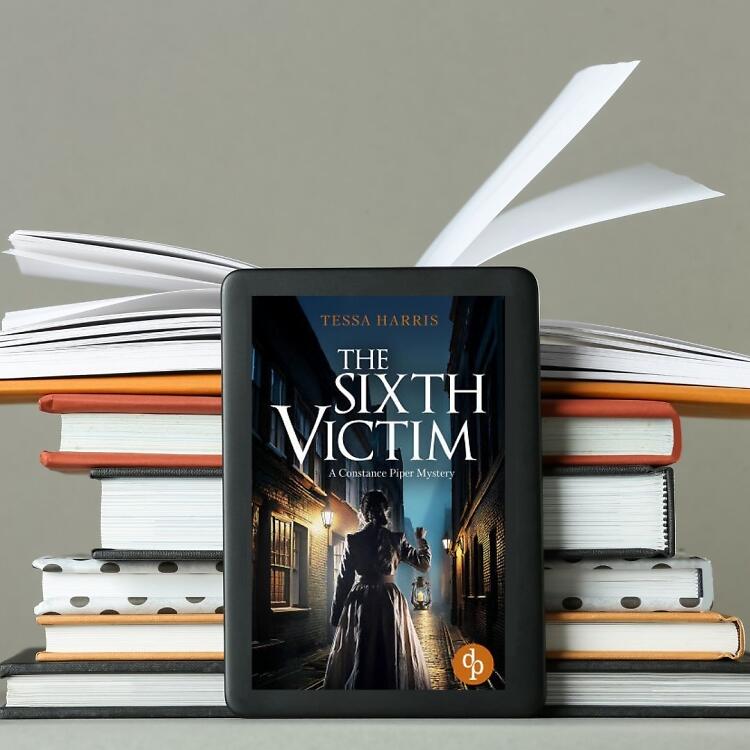Your novel blends historical crime with a supernatural twist. What inspired you to combine these two elements?
I wanted there to be an ambiguity about the plot. It can be read in two ways; either Constance really is able to communicate with someone in the afterlife or she simply believes she can. Perhaps her contact with her beloved former mentor is purely a psychological crutch. Could it be this belief gives her the confidence she needs to confront her situation and take action? Or is she just fooling herself? I leave it up to the reader to decide.
Constance Piper is such an interesting character with her clairvoyant abilities. How did you come up with her personality and backstory?
A good friend of mine, Lynn Picknett, wrote a fascinating book about bizarre, paranormal experiences. In it, she featured the story of a young East End girl, who teamed up with a fashionable ‘scientist’ and appeared at seances as a ghost. Her nom d’apres vie was Katie King, but her real name was Florence Cook. When she was found to be a fraudster it caused a huge scandal, and I just loved the idea of a cheeky young Cockney pulling the wool over the eyes of so many ‘genteel’ people.
Whitechapel in 1888 is such a dark and atmospheric setting. Why did you choose this specific time and place?
I used to live just outside London and would travel to Brick Lane market at the weekend sometimes. The atmosphere is so incredible and cosmopolitan, but if you look closer, the past is all around. It’s not too difficult to travel back to those dark days, despite all the new developments.
Jack the Ripper is both a chilling and iconic figure in history. What drew you to write about his story?
Obviously, I knew Whitechapel was the former realm of Jack the Ripper. My previous books were all murder-mysteries and it’s a genre I love, so I bought a walking tour leaflet and let my imagination go to work. I also wanted to write about the terrifying crimes from a female perspective. What was it like to be a working-class woman in Whitechapel during his reign of terror? It’s the role of the historical novel to hold a mirror up to contemporary society. Sadly, we’re facing many of the same issues today as the Victorians faced – misogyny, child abuse and violence against women – remain ever-present.
Clairvoyance plays a key role in your novel. Do you personally believe in psychic abilities, or was it just an intriguing aspect for the plot?
If anyone asks, I say I don’t believe in ghosts. One day, however, a friend invited me to a séance. A chill went down my spine. I am far too afraid to go to a séance, in case I do make contact with ‘the other side.’ My husband and I also have a random code phrase. When one of us dies, we may go to a séance. If certain words are said, it’ll confirm there is something beyond. Does that mean I believe in life after death? I suppose I’m hedging my bets!
Constance navigates a tough world as a young woman in Victorian London. What do you think makes her a strong and relatable protagonist?
Constance speaks directly to the reader in the first person and has no filters. She can say what she thinks and because she’s still young and not attuned to polite society, she can speak truth to power.
The Victorian era has such a distinct atmosphere. How did you go about bringing this historical setting to life in your writing?
As I said, I spent endless hours just roaming the streets, exploring alleys and buildings, imagining what it would be like 150 years ago. As well as non-fiction research, I also immerse myself in films and novels set in the period. Sarah Waters is my favourite writer.
Your book balances mystery, crime, and supernatural elements. What was the biggest challenge in weaving these together?
I always like to stay as close as I can to the facts. These were real people, with real, often terrible lives. I wanted to give the women voices and blending the supernatural element with reality made that possible.
Constance’s case goes far beyond Jack the Ripper. What can readers expect from the twists and turns in the story?
Of course, the biggest twist comes at the end, but I can’t give that away. Let’s just say I lead the reader along the many blind alleys the police travelled down. Officially Jack the Ripper claimed five victims, but of course there were other murders during this period which may or may not have been committed by the same killer. The mysteries surrounding the period are fertile ground for a crime writer.

